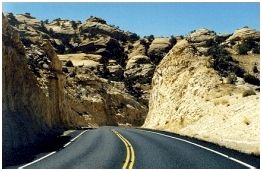
Scenic Byways
Scenic Byways Benefit Local Economies
State scenic byways programs across the country are helping communities to protect and promote the beauty of America's back roads.
Strong scenic byways programs preserve the beauty of the designated scenic corridors, which reaps rewards by protecting community character while providing economic opportunities in tourism and recreation.
An increasing number of studies demonstrate the economic benefits to identifying, protecting, and promoting scenic byways. Here's a sampling:
- The Blue Ridge Parkway, Virginia/North Carolina -- Visitors spent $1.8 billion in counties adjacent to the Blue Ridge Parkway, according to a 1995-96 study. These expenditures resulted in over $147 million in tax revenues and supported more than 74,614 jobs in the region.1
- Forty percent of American adults drive for pleasure, making it American adults' second favorite recreation activity, behind only walking.2
- Vermont Scenic Byways -- Travelers from out of state who drove Vermont Scenic Byways for the scenic drive or sightseeing spent 25% more per day than those traveling for other reasons.3
- Two-thirds of American adults drove on a leisure trip of a hundred miles or more in 1997 in 963 million person-trips. The American Automobile Association expects this number to grow to 990 million trips in 1998.4
- Colorado Scenic Byways -- A survey of tourism-related businesses along two scenic byways in Colorado showed that a majority of business owners estimated a 10% increase in sales due to byway designation.5
- Travel and tourism is a $440 billion a year industry, and the nation's third largest retail industry.6
- A US Travel Data Center study looked at the economic impacts of 1,600 miles of designated scenic roads all over the country. The study found that travelers spent almost $48 million while traveling on these roads, generating 920 jobs and $9 million in payroll income.7
- 96% of travelers surveyed on two scenic byways in New Hampshire "always" or "sometimes" consider scenic routes in their travel plans.8
But it's not enough to simply designate a road. States and communities that protect their distinctive scenic character enjoy benefits far beyond those they can see.
- In his book Leisure Travel: Making it a Growth Market...Again!, travel researcher Stanley Plog wrote about tourism development, "The most central feature that needs protection is the natural beauty and setting of a place. Once lost, it can seldom be restored."
- The 1994 American Traveler Survey asked 28,000 Americans where they'd most like to vacation. The leading domestic destinations were Alaska, Hawaii, Maine, Vermont, Colorado, Washington, and Montana - all known for protecting their outstanding natural beauty.
___________
Sources:
1. 1995-96 Economic Impact of Travel to the Blue Ridge Parkway, Virginia and North Carolina. (1997). By Gene Brothers and Rachel Chen, North Carolina State University.
2. Outdoor Recreation in America. (1994). Recreation Roundtable/Roper Starch Worldwide Survey.
3. An Analysis of the Economic Impacts of Scenic Byway Treatments in Vermont: A Pilot Study. (1996). Impact Research Associates, Inc.
4. "Auto Travel to Climb Nearly 3% in 1998," (October 1997) Automobile Association of America Travel News.
5. Colorado Scenic and Historic Byways, Economic Impact Study Interim Report. (1996). By John Sem, Patrick Goff and Sally Pearce.
6. Tourism Works for America. 1996 Report.
7. The Economic Impact of Travel on Scenic Byways. (1990). U.S. Travel Data Center.

Route 12, Utah
National Forest Scenic Byway
8. New Hampshire's Scenic Byways: Economic Impacts. (1990). New Hampshire Department of Transportation.
The Economic Impact of Historic Preservation
(taken directly from Balancing Nature and Commerce in Gateway
Communities by Jim Howe, Ed McMahon, and Luther Propst)
Income to the Community: One million dollars investedin rehabilitation versus one
million dollars in new construction means that
- $120,000 more will stay in the community
- $34,000 more in retail sales in the community
- $107,000 more in household incomes
- as many as nine more construction jobs willl be created in the community and five
more jobs elsewhere
Cost Savings: It costs 4 percent less to rehabilitate an older building than to
construct a new one. If demolition of an older building is required before construction
of a new one, the savings can be as much as 16 percent.
|

